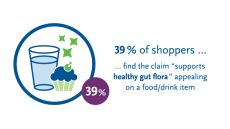Wine waste could boost stability and health profile of ice cream
winemaking, could boost the antioxidant profile of ice cream and
slow the melting time of ice cream, suggests a new study from
Taiwan.
The melting rate of ice cream was reduced by up to 80 per cent when the grape wine lees (GWL) was added, and simultaneously boosting the antioxidant profile of the ice cream, report the researchers in the journal LWT - Food Science and Technology. "In this study, we demonstrated that the addition of GWL could significantly increase the antioxidant activity of ice cream, and the antioxidant in the GWL appeared to be quite stable during the process of ice cream making," wrote lead author Jean-Yu Hwang. "Therefore, GWL has the potential to be used as a value-added ingredient in ice cream industry to enhance the antioxidant." The study taps into the growing trend of companies moving into the market for more premium products and unusual combinations of flavours in response to stagnation in the European ice-cream sector. This has been due to a maturation of the sector, health concerns and growing competition from cheaper private-label products, according to analysts. Researchers from Chung-Hwa University of Medical Technology, National Kaohsiung Hospitality College, and Asia University formulated ice cream using 50, 100 and 150 grams per kg of the grape lees, and compared to an ice cream without the lees. They report that the melting rate, firmness, pH, colour (lightness) and the amount of freezable water in ice cream decreased as a result of adding GWL, while increases in yellowness, viscosity, and the stability of fat particles were observed as a function of the dose used. Indeed, the melting rate was slowed by 32 per cent at the lowest GWL content (50 g per kg) and by more than 80 per cent at the higher concentrations. "However, ice cream with high GWL contents also showed unpleasant effects, such as the decrease of overrun and the increase of particle size of fat globule," they stated. "These unwanted effects were minor at low GWL concentration." In terms of antioxidant activity, an increase in the DPPH radical scavenging activity was observed, equally an improvement in the antioxidant profile of the ice cream. "It appeared that the antioxidants in GWL were quite stable to the process of ice cream making," they added. Ice cream market According to a Euromonitor study companies in the ice cream market need sensitivity to changing regional tastes, exotic flavour mixes, labelling and packaging to be successful in attacking Western Europe's stagnant ice cream market Sales of ice cream decreased by 0.4 per cent to US$20.3bn in 2004 in the region, according to Euromonitor. Processors are focusing on introducing unusual flavors and premium brands to hold on to their market shares. The trend is known in the industry as the "premiumisation of flavour". More demanding consumers are willing both to experiment with new taste sensations and to pay a higher price for more sophisticated and less traditional products, the analyst said. Source: LWT - Food Science and Technology (Elsevier) Published online ahead of print 16 March 2008, doi: 10.1016/j.lwt.2008.03.008 "Grape wine lees improves the rheological and adds antioxidant properties to ice cream" Authors: J.-Y. Hwang, Y.-S. Shyu, C.-K. Hsu





















